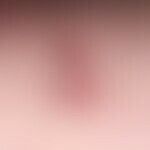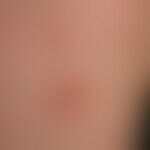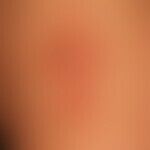Synonym(s)
HistoryThis section has been translated automatically.
DefinitionThis section has been translated automatically.
Rare, gynecotropic, idiopathic, eminently chronic, granulomatous systemic disease, which manifests itself on the integument and here preferentially on the lower legs in the form of large brown-red plaques, if persisting for a long time, also ulcerated then also painful. An association with diabetes mellitus is present in about 65% of patients.
Granulomatosis disciformis chronica et progressiva is considered by some authors as a special form of necrobiosis lipoidica, by others as a differential diagnosis.
You might also be interested in
Occurrence/EpidemiologyThis section has been translated automatically.
Common in diabetes mellitus patients. Frequency in diabetics: 3/1,000 patients.
In larger collectives, the following comorbidities are listed, although the etiological relationships cannot be clearly verified, except for diabetes mellitus:
- Diabetes mellitus type I (E10) 20.6%.
- Diabetes mellitus type II (E11) 13.7%
- Diabetes mellitus in pediatric collectives (E10) 90%
- Essential hypertension (I10) 9.2%
- Ulcus cruris (L97): 7,3%
- Other venous diseases, varices of the lower extremities (I87/3): 5,7%
- Obesity (E66): 4,6%
- Heart failure (I50): 4,1%
- Lipoprotein metabolism disorders (E78): 2,3%
- Psoriasis (L40): 2,3%
- Erysipelas (A46): 2,3%
- Multiple sclerosis (G35): 1.9%
In pediatric collectives, there is a clear association between necrobiosis lipoidica and diabetes mellitus at around 90% (Berman HS et al 2021).
EtiopathogenesisThis section has been translated automatically.
Systemic granulomatosis of unknown etiology.
Associations with diabetes mellitus, hypertension, Crohn's disease, ulcerative colitis, granuloma anulare, or cutaneous sarcoidosis have been described (see previously). A large population-based cohort study found associations between the Adapted Diabetes Complications Severity Index, insulin use, microvascular complications (+hospitalizations), and necrobiosis lipoidica (Berna R et al. 2022).
In smaller pediatric NL collectives, an association with diabetes mellitus can be established in approximately 90% of those affected. This percentage is etiopathogenetically significant than in these pediatric collectives vascular concomitant components such as CVI, pAVK, and hypertension are not relevant (Berman HS et al. 2021).
Associated vascular changes(microangiopathy, fibronectin and factor 8 associated antigen elevation, disturbances in prostaglandin synthesis), sweat gland changes, collagen disturbances, immune mechanisms, impaired leukocyte functions are discussed.
Occasional occurrence in older scars has been reported (see Fig.).
To what extent trauma (with corresponding disposition) plays an initiating role remains open. However, localizations at mechanically exposed sites support this hypothesis (this must be taken into account in therapy).
ManifestationThis section has been translated automatically.
Occurring mainly in middle age (50-55 years). Average age: 52 years (Erfurt-Berge C et al. 2015). Approximately 10% of affected individuals are distributed between the age groups 75-80 and 15-20 years. Weige reports exist of disease in children and adolescents (3-15 years/Berman HS et al. 2021).
LocalizationThis section has been translated automatically.
Mainly lower leg extensor sides, dorsum of foot, ankle region, in 15% other body regions (dorsum of hand, foramen). Initially unilateral; symmetrical manifestations are possible.
Clinical featuresThis section has been translated automatically.
Frequently occurring after a (often not remembered) minor trauma, irregularly configured, sharply demarcated, atrophic, indurated plaque with a yellow to brownish-yellow, speckly shiny center, interspersed with telangiectasias. The initial focus is barely the size of a coin, clinically unremarkable, and often misrecognized as a traumatic hemosiderin deposit. Early lesional hair loss is suggestive of necrobsiosis lipoidica.
A reddish-purple to brown-red rim indicates ongoing inflammatory activity and peripheral growth.
The foci (or foci) show gradual but continuous centrifugal growth over months and years. Confluence of multiple foci is possible, resulting in map-like plaques (see Fig.).
The subcutis may also be involved in granulomatous inflammation. This deep component results in atrophy of the subcutaneous adipose tissue with depression of the atrophic surface. This results in increased vulnerability of the foci with a tendency to chronic ulcer formation .
Lesional ulcers: In about 30% of cases, poorly healing, painful ulcers with a yellowish speckled, necrotic base develop in the lesions, following trivial trauma; depending on the localization (e.g., tibial edge), there may also be (painful) accompanying periostitis.
Healing with atrophy of skin and subcutaneous fat with (early) loss of skin appendages is possible, but rather rare.
Rare special forms:
- Necrobiosis lipoidica maculosa disseminata
- Necrobiosis lipoidica on forehead and head area. In the area of the hairy head (extremely rare localization) formation of a pseudopelade.
HistologyThis section has been translated automatically.
Epidermis thinned, otherwise without specific changes. In the middle and lower dermis, sometimes also in the subcutaneous adipose tissue, there are nodular or striated granulomatous inflammatory zones consisting of histiocytes, epithelioid cells and multinucleated giant cells of varying composition, as well as focal nests of lymphocytes and plasma cells. Sporadic formation of lymphoid follicles. In some cases plasma cells may dominate the picture.
In addition to this inflammatory component, the cutis is characterized by extensive degenerative changes of the collagen (collagen necrobiosis). The zones of necrobiosis may occur in the midst of a granulomatous nodule, but may also alternate with granuloma zones in a sandwich-like fashion. Wall-thickened or occluded vessels may be consistently detectable. Granulomatous inflammation may involve the subcutaneous fat tissue.
Gradual differences between diabetic and nondiabetic patients can be demonstrated in inflammatory rection. More common in diabetics are: acanthosis, sarcoid/tuberculoid granulomas, neutrophilic infiltrates. In contrast, eosinophilic granulocytes are more commonly encountered in non-diabetics than in diabetics (Johnson E et al 2022).
The extent to which granulomatosis disciformis chronica et progressiva represents a distinct entity remains to be discussed. Most likely, it is a (non-necrobiotic) variant without diabetes mellitus.
DiagnosisThis section has been translated automatically.
Differential diagnosisThis section has been translated automatically.
Complication(s)This section has been translated automatically.
Ulcers: The most important and serious complication is ulceration, which occurs on the legs in about one-third of NL cases (Grillo E et al. 2014).
Malignancies: Within a larger contingent, intralesional cutaneous malignancies developed within necrobiosis lipoidica in about 2% of affected individuals. Quite predominantly, these were spinocellular carcinomas, in addition to basal cell carcinomas and malignant melanomas. The median time between the diagnosis of necrobiosis lipoidica and the development of malignancy was 6 years, and that between the appearance of necrobiosis lipoidica symptoms and the development of malignancy was 9 years. Lesion-associated malignancies were located on the tibia and were ulcerated (Harvey JA et al 2022).
TherapyThis section has been translated automatically.
A plethora of different therapeutic proposals exist, which on the other hand means that there is no such thing as "the promising form of therapy". The treatment has to be adapted to the local situation (age of the lesion, large or small foci, ulcerated or non-ulcerated) and to a possible underlying systemic disease (e.g. diabetes mellitus). Important: Any treatment approach requires patience from both physician and patient. It is to be applied for years.
General therapyThis section has been translated automatically.
Treatment of the underlying disease, e.g. diabetes mellitus (adjustment of blood sugar!), hypertension, Crohn's disease (see enteritis regionalis), ulcerative colitis. As a rule, however, treatment of the underlying disease does not improve the cutaneous symptoms.
In the case of localization on the lower legs, consistent compression therapy should always be carried out during treatment, as this relatively often prevents progression and promotes healing (always carry out arterial Doppler sonography before compression therapy). In addition, prophylactic protection of the lower leg (padded compression stocking) against banal trauma is recommended.
External therapyThis section has been translated automatically.
In general, prophylactic protection of the lower legs (padded compression stocking) against trivial trauma is recommended.
Non-ulcerated skin lesions:
- Therapy of choice are topical glucocorticoids, e.g. Mometasone (Ecural®) under occlusion. Permanent wear, alternating 1 time/day for 14 days to 4 weeks.
- Several case reports reported healing/improvement of NL under topical therapy with 0.1% Tacrolimus (Protopic®).
- Alternative:
- Injectglucocorticoids intrafocally, 1 time/month for 2-3 months, e.g. triamcinolone acetonide (e.g. Volon A 10 1:1 with scandicaine). Cave: painfulness; compliance!
- Good results have been reported with PUVA therapy.
Ulcerated foci (systemic therapy is recommended, local therapy= ergative but mandatory):
- Ulcer -adapted wound therapy.
Internal therapyThis section has been translated automatically.
In case of ulceration or highly inflammatory component, try systemic therapy with glucocorticoids in medium dosage such as prednisolone 60-80 mg/day (e.g. Decortin H) for one week, then 30 mg/day for one month. Caveat. Monitor blood glucose levels! After ulcers have healed, transition to non-steroidal alternative therapy (e.g., fumaric acid esters or TNF-alpha blockers).
Alternative: Fumaric acid esters in the therapeutic modality indicated for psoriasis (see below Psoriasis vulgaris).
Alternative: Ciclosporin A systemically: Initial 2.5-7.5 mg/kg bw/day p.o., after one month gradual reduction to a maintenance dose of 1-2.5 mg/kg bw/day. By determining the blood plasma level, an optimal active level of 100-200 ng/ml can be set (blood collection in the morning, before taking the preparation!).
Alternative: TNF-alpha blockers: there are reports of success with infliximab, etanercept, adalimumab (Palomares SJ et al. 2023). Adalimumab a TNF-alpha blocker (initially 80mg s.c.,1 week later 40mg s.c.; maintenance therapy 40mg s.c. every 14 days).
Alternative: Ustekinumab, a human monoclonal antibody directed against the p40 subunits of the cytokines interleukin-12 (IL-12) and -23 (IL-23) (Beatty P et al 2021).
Alternative: Tofacitinib, a Janus kinase inhibitor (JAK inhibitor) with immunomodulatory properties (McPhie ML et al. 2021).
Alternative: Mycophenolate mofetil systemic: Initial 2.5-7.5 mg/kg bw/day p.o. As continuous therapy, mycophenolate mofetil monotherapy at 1.0 g/2 times/day p.o.
Alternatively or additively: Pentoxifylline (e.g. Trental) 3 times/day 400 mg p.o. or Nicotinamide (e.g. Nicobion 3 times/day 500 mg p.o. can be tried supportively. In persistent cases, if necessary, acetylsalicylic acid 1.5-4.5 g/day p.o., dipyridamole (Curantyl) 225 mg/day p.o. individually or in combination (Aggrenox).
Experimental: Assuming that hypoxia in the tissues is a major cause of the disease, experimental approaches attempt to achieve improvements by oxygenating the blood.
Progression/forecastThis section has been translated automatically.
Extremely chronic course over years/decades (see Fig. with course controls over >5 years). Possible complications due to ulceration.
Spontaneous healing is reported in 20% of cases. Healing always occurs with atrophic scarring.
LiteratureThis section has been translated automatically.
- Aslan E et al (2007) Successful therapy of exulcerated necrobiosis lipoidica non diabeticorum with ciclosporin. Dermatologist 58: 684-685
- Aye M et al (2002) Dermatological care of the diabetic foot. Am J Clin Dermatol 3: 463-474.
- Berna R et al (2022) Exploring the association between granuloma annulare and severity of type 2 diabetes in a large administrative database. J Am Acad Dermatol 87:918-920.
- Berman HS et al (2021) Pediatric necrobiosis lipoidica: case report and review of the literature. Dermatol Online J 15;27.
- Barth D et al (2011) Topical use of tacrolimus in necrobiosis lipoidica. Dermatologist 62: 459-462
- Beattie PE et al (2006) UVA1 phototherapy for treatment of necrobiosis lipoidica. Clin Exp Dermatol 31: 235-238.
- Beatty P et al (2021) Ulcerating necrobiosis lipoidica successfully treated with ustekinumab. Australas J Dermatol 62:e473-e474.
- Berman HS et al.(2021) Pediatric necrobiosis lipoidica: case report and review of the literature. Dermatol Online J 15;27.
- Bonura C et al. (2014) Necrobiosis lipoidica diabeticorum: A pediatric case report. Dermatoendocrinol 6:e27790.
- De Rie MA et al (2002) Treatment of necrobiosis lipoidica with topical psoralen plus ultraviolet A. Br J Dermatol 147: 743-747.
- Dwyer CM et al (1993) Ulceration in necrobiosis lipoidica - a case report and study. Clin Exp Dermatol 18: 366-369
- Erfurt-Berge C et al (2012) Update on clinical and laboratory features in necrobiosis lipoidica: a retrospective multicentre study of 52 patients. Eur J Dermatol 22:770-75.
- Erfurt-Berge C et al. (2015) Updated results of 100 patients on clinical features and therapeutic options in necrobiosis lipoidica in a retrospective multicentre study. Eur J Dermatol 25:595-601.
- Gambichler T et al (2003) Clearance of necrobiosis lipoidica with fumaric acid esters. Dermatology 207: 422-424
- Grillo E et al (2014) Necrobiosis lipoidica. Aust Fam Physician 43:129-30.
- Harvey JA et al (2022) Necrobiosis lipoidica-associated cutaneous malignancy. J Am Acad Dermatol 86:1428-1429.
- Jockenhöfer F et al. (2016) Cofactors and comorbities in necrobiosis lipoidica-analysis of 2012 German DRG data. JDDG 13: 277-285.
- Johnson E et al (2022) Histopathologic features of necrobiosis lipoidica. J Cutan Pathol 49:692-700.
- Kreuter A et al (2005) Fumaric acid esters in necrobiosis lipoidica: results of a prospective noncontrolled study. Br J Dermatol 153::802-807.
- Leister L et al (2013) Successful treatment of a patient with refractory exulcerated necrobiosis lipoidica non diabeticorum. Dermatologist 64: 509-511
- McPhie ML et al (2021) Improvement of granulomatous skin conditions with tofacitinib in three patients: A case report. SAGE Open Med Case Rep 9:2050313X211039477.
- Marcoval J et al (2015) Necrobiosis lipoidica: a descriptive study of 35 cases. Actas Dermosifiliogr 106: 402-407.
- Oppenheim M (1929) Peculiar disseminated degeneration of connective tissue in a diabetic patient. Zentralbl Haut- und Geschlechtskrankh (Berlin) 32: 179.
- Oppenheim M (1932) A not yet described skin disease in diabetess mellitus (dermatitis atrophicans lipoides diabetica). Wiener klin Wochenschr 45: 314-315
- Özkur E et al (2019) Atypical presentation of necrobiosis lipoidica in a pediatric patient. Pediatr Dermatol 36:e31-e33.
- Palomares SJ et al (2023) Nonulcerated necrobiosis lipoidica Successfully Treated with Tapinarof: A Case Report. Clin Cosmet Investig Dermatol 16:1373-1376.
- Pătraşcu V et al (2014) Ulcerated necrobiosis lipoidica to a teenager with diabetes mellitus and obesity. Rome J Morphol Embryol 55:171-176
- Sandhu VK et al (2019) The role of anti-tumour necrosis factor in wound healing: A case report of refractory ulcerated necrobiosis lipoidica treated with adalimumab and review of the literature. SAGE Open Med Case Rep 7:2050313X19881594
- Tokura Y et al (2003) Necrobiosis lipoidica of the glans penis. J Am Acad Dermatol 49: 921-924.
- Urbach E (1932) Contributions to a physiological and pathological chemistry of the skin. X. A new diabetic metabolic dermatosis. Necrobiosis lipoidica diabeticorum. Arch Dermatol Syphil (Berlin) 166: 273.
- Thomas M et al (2013) Necrobiosis lipoidica: A clinicopathological study in the Indian scenario. Indian Dermatol Online J 4:288-291.
- Weidenthaler-Barth B (2017) Clinical and histological spectrum of palisaded granulomatous dermatitides: granuloma annulare, necrobiosis lipoidica, rheumatoid nodules, and necrobiotic xanthogranuloma. Dermatologist 68:536-541.
Incoming links (29)
Adiposity skin changes; Atrophie blanche; Collagenosis reactive perforating; CVID; Dermadrome; Dermatitis atrophicans lipoides diabetica; Dermatoliposclerosis; Diabetic necrosis lipoidica; Dyslipoidosis cutanea; Giant cell granuloma anular elastolytic; ... Show allOutgoing links (35)
Acetylsalicylic acid; Adalimumab; Atrophy of the skin (overview); Atypical mycobacterioses; Chronic venous insufficiency (overview); Ciclosporin a; Circumscribed scleroderma; Compression therapy; Crohn disease, skin alterations; Dipyridamole; ... Show allDisclaimer
Please ask your physician for a reliable diagnosis. This website is only meant as a reference.













































